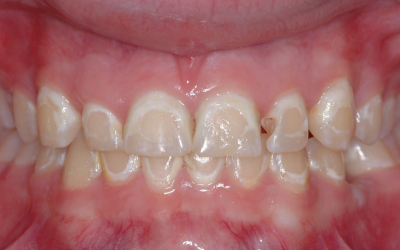Blog
We all know how important it is to brush your teeth twice a day to remove food debris and plaque from our teeth. We do this to help to prevent tooth decay and gum inflammation (gingivitis). It’s much better to prevent these issues rather than receive costly treatment for these diseases.
However, plaque and food debris can accumulate much easier and in larger quantities around braces so brushing is even more important. In addition, there is the added problem of the acidity of plaque causing loss of calcium from the enamel, a process called decalcification which then leaves white spots on the teeth. This can be treated by your dentist but it is an unnecessary expense which can be easily prevented.
Tooth decay in the upper left front teeth and white patches in the enamel as a result of not brushing properly.

Tooth decay in the upper left front teeth & white patches in the enamel as a result of not brushing properly.
1. Rinse your mouth before you brush
Plenty of food can accumulate around braces and get lodged in between the wires and brackets so vigorous rinsing will loosen those food particles so that your toothbrush and toothpaste can come in to direct contact with the tooth enamel.
2. Electric toothbrush is best
For most people, a good brand electric toothbrush is more efficient at removing plaque but if used properly and for a good 2 minutes of efficient brushing, a manual toothbrush can be just as effective. You don’t need to buy the most expensive electric toothbrush unless you like all the “bells and whistles”, special colours that the expensive models can have. Indeed the good brand cheap brushes have been shown to be just as good as the expensive models of the same brand.
3. Use a good toothpaste
The popular brand toothpastes which contain fluoride and may contain other active ingredients are the best toothpastes to use. There are some very expensive toothpastes that have recently been released with very good marketing campaigns. These toothpastes claim to be natural with unproven health benefit claims but in fact, they have no therapeutic value so we don’t recommend these toothpastes.
4. Use floss or interdental brushes
Floss or interdental brushes should be used either before or after brushing to clean in the areas where the toothbrush areas cannot access. Your dental hygienist can recommend the appropriate floss and size of interdental brush which is suitable for you. It’s also a good idea to ask the hygienist to show you how to use these products.
5. Rinse with a mouthwash after brushing
After you have completed your brushing and flossing, it’s a good idea to rinse your mouth a popular brand therapeutic mouthwash to counteract any plaque bacteria which may have been left behind after brushing and flossing. These bacteria can accumulate it many little nooks and crannies where the toothbrush bristles and floss cannot reach. The mouthwash will also help to get rid of any further loose food particles and other debris.
For further information about looking after your teeth with braces Glenroy, Essendon or Coburg, please call our office on (03) 9386 1805.




